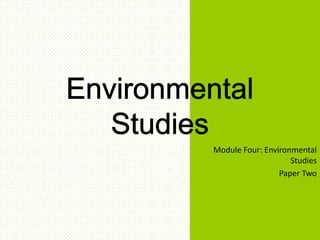
Environmental Studies
- 1. Module Four: Environmental Studies Paper Two
- 2. Humans influence the environment in the following areas: • Air • Water • Land Pollution is the addition of any element (a pollutant) into an ecosystem which causes damage to the living organisms or to the environment of that system.
- 3. • Air pollutants are made up of gases, liquids and solids present in the atmosphere. They may be released due to natural processes (e.g. a volcanic eruption) or due to human activity. • Pollutants may be: – Primary pollutants: substances given off directly into the atmosphere such as carbon dioxide, from burning fossil fuels. – Secondary pollutants: substances formed in the air from the reaction of primary pollutants, such as sulphuric acid. • Know about global warming, the Kyoto Protocol and smog.
- 4. • Causes of water pollution: – Toxins in waterways from agriculture and industry – Pathogens in sewage – Accelerated eutrophication – Pollutants discharge into the sea • Toxins in water: – Pesticides used in agriculture – Heavy metals from industry – Mining activity
- 5. • Pesticides: – Do not break down and can be passed along in a food chain. The concentration of many pollutants builds up in the fatty tissue of animals (bioaccumulation). – Eating such animals will result in abdominal cramps, nausea, vomiting, constriction of pupils, respiratory problems and endocrine disruption. – Use of pesticides should be reduced, or replaced with the a natural predator (biological control of pests). • Mining: – Contaminates soil, poisons underground water with heavy metals, and pollutes the air. • Heavy metals: – Camium and lead, as well as mercury, is released into water by industry. – Camium affects kidneys while lead damages the nervous system. – Mercury in children will affect the development of the brain and other parts of the nervous system.
- 6. • Sewage is waste water from houses and industries. Waste collects in sewers and consists of water, urine and faeces, toilet paper, detergents, oil and chemicals. • There are more than 400 different viruses and bacteria in urine and faeces in sewage, many of which are pathogens. Drinking infected water can cause gastrointestinal diseases such as dysentery, cholera or typhoid. – Dysentery is caused by bacteria, viruses and protozoa that live in faeces. They cause inflammation of the lining of the large intestine, pain, and severe diarrhoea – resulting in a loss of water and salts, can be fatal. – Cholera is a severe form of diarrhoea. Leads to dehydration. Caused by drinking contaminated water. – Typhoid is caused by a bacterium and enters the body through the mouth in food or water and causes a high fever and damage in the intestines.
- 7. • Fertilizer can be washed away when it rains (leaching). • Encourages excessive growth of aquatic weeds and algae, causing a thick green scum known as algal bloom. • Prevents deeper plants from getting sunlight, causing them to DIE. • Increases the uptake of dissolved oxygen by bacteria that are decomposing organic matter. Algae also die from lack of oxygen. • Lack of oxygen kills many invertebrates. • Accelerated eutrophication can result in a ‘dead river’ or a ‘dead lake’.
- 8. • About 80% of marine pollution in South Africa originates on the land from: – Discharge of untreated sewage – Coastal mining – Bad farming – Contaminated storm water • Oil spills are also a huge risk for South Africa, as lots of oil is transported around the coast.
- 9. • Legislate against sewage
- 10. • Waste management is the collection, transport, processing, recycling or disposal of waste materials which can be solid, liquid, gaseous or radioactive. • Industrial waste is generated from factories, which have to dispose of it. Domestic waste is collected from homes, offices, schools etc. and taken to landfill sites by local authorities. • Hazardous waste is made up of toxic chemicals, radioactive waste, medical waste and e-waste. • E-waste is electronic waste, and includes old computers, TVs, batteries etc. They can contain lead, mercury and cambium. • Litter is waste thrown into the environment and not into waste containers
- 11. • Rubbish dumps are created when domestic waste is dumped on open ground. They are unsatisfactory as they are unsightly and smelly, a breeding ground for pests, can cause water pollution and release toxins and chemicals when burnt. • Landfills dispose of waste by burying it. The rubbish is buried specially, lined with clay or plastic to keep out vermin. Micro- organisms degrade the rubbish in a process of biodegradation.
